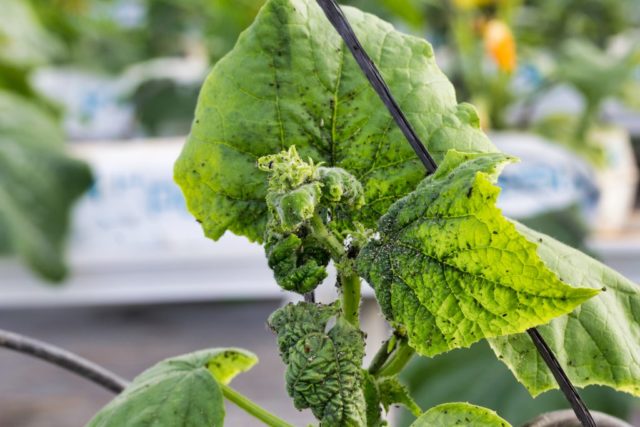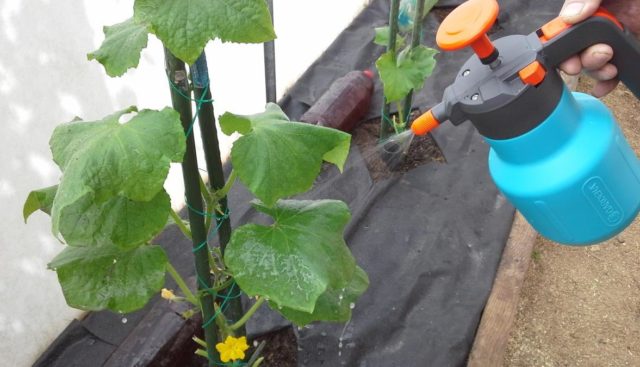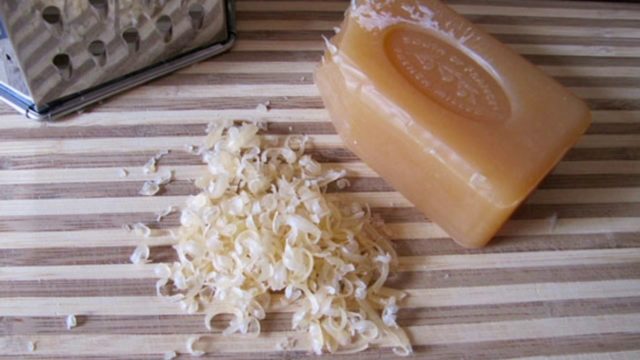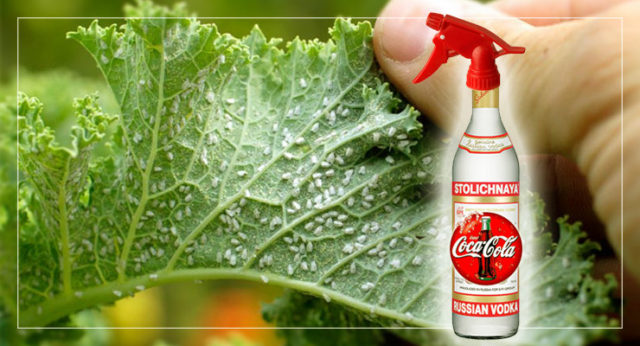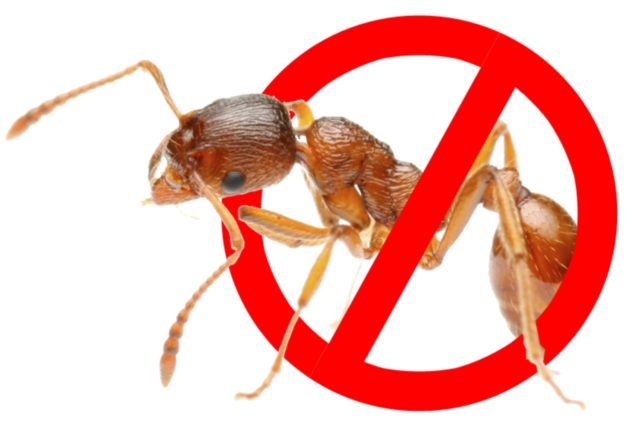Content
- 1 Why aphids are dangerous for cucumbers
- 2 Ways to combat aphids in cucumber beds
- 3 How to get rid of aphids on cucumbers by chemical means
- 4 How to deal with aphids on cucumbers with biological preparations
- 5 How to deal with aphids on cucumbers with folk remedies
- 5.1 How to save cucumbers from aphids with ammonia
- 5.2 How to destroy aphids on cucumbers with mustard powder
- 5.3 How to remove aphids from cucumbers using vinegar
- 5.4 Hydrogen peroxide from aphids on cucumbers
- 5.5 Wood ash treatment
- 5.6 Soap in the fight against aphids on cucumbers
- 5.7 Onion peel - an effective remedy for aphids on cucumbers
- 5.8 Other folk remedies for aphids on cucumbers
- 6 How to sprinkle cucumbers from aphids at different stages of development
- 7 How to protect cucumbers from aphids
- 8 Conclusion
Aphids are a well-known garden pest that parasitizes almost all cultivated plants. Despite its microscopic size, the insect causes great harm to plantings due to its abundance. Aphids on cucumbers are quite common, so plantings should be regularly inspected and urgent measures should be taken if pests are found. Inaction can lead to a complete lack of crops and plant death.
Why aphids are dangerous for cucumbers
The melon aphid most often settles on cucumbers. It is a sucking pest that feeds on plant juices. The insects themselves do not differ in significant size, an adult does not grow more than 2 mm. However, their extreme fertility poses a serious threat; within a few days, a colony of aphids can grow hundreds of times. For their nutrition, insects make numerous punctures in the leaf plates and in young stems, which leads to the oppression of the plant. Their growth stops, the shoots are deformed, the leaves of the cucumbers curl and gradually die off.
No less harm to plants is caused by aphid secretions - a sweet honeydew that attracts ants. This sticky white substance coats the leaves, closing pores and blocking air exchange. Ants that feed on honeydew use aphids as a kind of milking cows, transferring them to new areas and in every possible way protecting them from dangers.
Another danger for cucumbers is that these insects are carriers of dangerous viral diseases such as mosaic. By piercing the leaves, these pests deliver the virus directly to the internal tissues of the plant, which leads to a rapid and extensive infection, usually resulting in the death of the plantings.
Ways to combat aphids in cucumber beds
There are many ways to protect the planting of cucumbers from the invasion of aphids. These include the following.
- Mechanical. Small colonies can be washed off with water or wiped off with a damp cloth.
- Biological. Such methods include planting next to cucumbers and laying out in the aisles of some plant species that repel aphids.
- Chemical. They consist in the treatment of plantings with various means that destroy insects.
How to get rid of aphids on cucumbers by chemical means
Aphid chemicals include intestinal and contact insecticides. They act quite quickly and efficiently, but their use is possible only for a limited time, namely at the beginning of the growing season. Blooming cucumbers cannot be processed, as this will kill not only aphids, but also bees pollinating the plants.An additional side effect of the use of such products is that the toxins contained in insecticides can accumulate in the fruits or in the soil and are removed from there for a rather long time. Therefore, after using some chemicals before harvesting, it is necessary to withstand a certain time, sometimes up to 20-30 days.
The following chemical preparations for aphids on cucumbers are effective remedies for aphids:
- Inta-Vir.
- Karbofos.
- Spark.
- Fufanon.
- Commander.
- Actellic.
For the processing of cucumbers, the drug is diluted in clean water in accordance with the recommendations indicated on the package. For processing plantings, it is better to choose a dry, cool day. All plants should be sprayed, paying special attention to the back of the cucumber leaves, which is usually home to aphids.
How to deal with aphids on cucumbers with biological preparations
Biological products have one indisputable advantage over insecticides: they are less toxic and more environmentally friendly. Usually, such remedies are used at an early stage of the appearance of aphids. These drugs include:
- Aktofit.
- Biolin.
- Bitoxibacillin.
- Arrow.
- Tanarek.
- Fitoverm.
Unlike chemical preparations, the active substance, for example, in Fitoverm, is a neurotoxin of biological origin, isolated from some groups of soil fungi. When this compound enters the insect's body, the nerve centers are blocked, because of which the pest stops moving and feeding and after a certain time dies.
Cucumbers are treated with biological products by spraying, as well as when using chemicals. It is very important to adhere to the indicated dosage when preparing the solution, otherwise other insects may suffer from the use of such compositions.
How to deal with aphids on cucumbers with folk remedies
There are many ways to remove aphids on cucumbers, time-tested many times. Many of them are absolutely harmless and are aimed not at destruction, but at scaring away the pest. It is possible to use such remedies against aphids on cucumbers during fruiting.
How to save cucumbers from aphids with ammonia
An aqueous solution of ammonia (ammonia) is a good remedy against aphids on cucumbers. To prepare the solution, you need 50 ml of ammonia. It must be diluted in 10 liters of clean water. For better wetting and holding capacity, liquid soap and vegetable oil (3-5 tablespoons) are added to the solution. With this composition, you need to process the plants, systematically sprinkling all the cucumber lashes.
How to destroy aphids on cucumbers with mustard powder
Add 100 g of mustard powder to 3 liters of boiling water. Mix well, let stand. After the powder has settled, carefully drain the resulting infusion from the sediment. Cool, add up to a whole bucket of clean water, soap and 4-5 tbsp. l. vegetable oil.
How to remove aphids from cucumbers using vinegar
Vinegar is cheap and effective against aphids, but it should be used with great care. This substance is a fairly strong organic acid and, if the concentration is exceeded, can leave burns on the leaves. It will take 1 tbsp. l. food vinegar 9%, dissolved in 1 liter of pure water, 1 tbsp. l. soap in shavings or solution.
The use of a vinegar solution for spraying cucumbers from aphids - in the video:
Hydrogen peroxide from aphids on cucumbers
Hydrogen peroxide is not only an effective remedy against aphids and other pests, but also a good top dressing. To prepare a spray composition for 1 liter of water, you need to take 50 ml of peroxide and 50 g of granulated sugar.Hydrogen peroxide is an unstable substance and decomposes in the open air, so the treatment is repeated several times with an interval of 7-10 days.
Wood ash treatment
Many gardeners use wood ash as fertilizer for fertilizing, as well as a means for deoxidizing the soil. The infusion of this substance is a weak alkali, therefore it is used to normalize the pH level in the soil, along with such agents as dolomite flour, chalk or lime. To prepare a composition for spraying cucumbers from aphids, you need to dilute 0.2 kg of wood ash in 10 liters of water and insist for a day.
A little liquid detergent is added to the mixture for better fixation on the leaves.
Soap in the fight against aphids on cucumbers
Soap solution is quite effective and safe and easy to prepare. You need to take 10 liters of clean water and add to it 100 g of laundry soap, previously grated. With such a solution, you can not only process cucumbers, it is also used to wipe the leaves on which the aphid colony is located. The soapy solution not only washes away insects, but also removes debris.
Onion peel - an effective remedy for aphids on cucumbers
Infusion of onion peels is a fairly effective and absolutely safe way for plants to get rid of small sucking insects. To prepare this product, you need 0.2 kg of onion peel to pour 10 liters of boiling water. After that, the infusion should be allowed to brew for 4-5 days. Then the product needs to be filtered, after which you can start processing cucumbers.
Other folk remedies for aphids on cucumbers
Processing cucumbers from aphids during fruiting and the rest of the time can be done with other folk remedies. The most popular ones are:
- Coniferous extract. To prepare the solution, 1 tsp is enough. extract to dissolve in 10 liters of water. For better retention on the leaves, it is advisable to add a few drops of liquid soap.
- Tobacco dust. This is a fairly effective remedy against many pests. To prepare the infusion, it is necessary to pour 0.2 kg of tobacco dust into 10 liters of water. Insist for a day. After that, the solution is filtered, 50 g of soap shavings are added to it, after which the cucumbers are processed. Not all gardeners consider the use of tobacco dust acceptable because of the nicotine content in its composition, therefore, in the infusion, many are quite successfully replaced with celandine or dandelions.
- Garlic water. In 10 liters of boiling water, it is necessary to squeeze out 150 g of fresh garlic. Insist for a day, then strain, after which you can use the infusion to spray cucumbers from aphids.
- Baking soda. The well-known sodium bicarbonate can also be used for treating cucumbers from aphids in greenhouses and exhaust gases. To prepare the solution, you will need 10 liters of clean water and 50 g of baking soda. The components must be mixed, adding a few tablespoons of sunflower oil and liquid laundry soap for better fixation on the leaves, and then water the cucumbers from the aphids.
- Vodka. According to gardeners, water-alcohol liquid is an excellent remedy for aphids. This method has one significant drawback - the price.
- Coca Cola. This popular fizzy drink contains aphid-killing phosphoric acid.
How to sprinkle cucumbers from aphids at different stages of development
The sooner it is possible to detect aphid colonies, the more gentle methods it is possible to destroy. Therefore, it is necessary to inspect the planting of cucumbers daily, and if insects are found, immediately take action. At the initial stage, aphids can be dealt with by simply washing it off with a stream of water or wiping the leaves with a piece of rag dipped in soapy water. If the aphid population has reached a significant number, it is necessary to use biological, and in extreme cases - chemical means.
Insecticides can be applied before flowering and after fruit setting.At the same time, a certain time must pass before harvesting, during which the chemical substance either decomposes into safe components, or its concentration becomes harmless. This period depends on the type of insecticide and is necessarily indicated on its product packaging. Biological agents can be used during all periods of cucumber growth, however, they also have restrictions on their use before harvesting.
Folk remedies are the safest and can be used throughout the growing season. However, even they should not be abused. About 1 month before harvesting, you should not spray cucumbers from aphids, otherwise the cucumbers will have a foreign taste and bitterness.
How to protect cucumbers from aphids
Prevention of the appearance of aphids on cucumbers is very important, because it is always better to prevent the disease than to deal with its consequences. In order to prevent the invasion of insect pests, it is necessary to maintain good air exchange in greenhouses, to prevent thickening of the plantings, to promptly remove drying and twisted leaves and tops. It is imperative to get rid of ants in the area and not break cucumber beds next to anthills. Discovered ant colonies are poured with boiling water.
To protect cucumber beds from aphids, it is recommended to plant nearby plants with a strong odor that are not exposed to the invasion of these pests, for example, garlic. It's also good if crops grow nearby that attract natural enemies of aphids, such as the ladybug. These include carrots, dill, etc.
Conclusion
Aphids appear on cucumbers quite often, but there are many tools in the gardener's arsenal to resist the invasion of these pests. In many cases, this problem can be solved without the use of heavy pesticides, the use of which for any purpose is always an extreme measure. You always need to start with prevention, and if necessary, try to destroy aphids on cucumbers, first of all, using folk remedies, using the most gentle, safe and environmentally friendly drugs.
